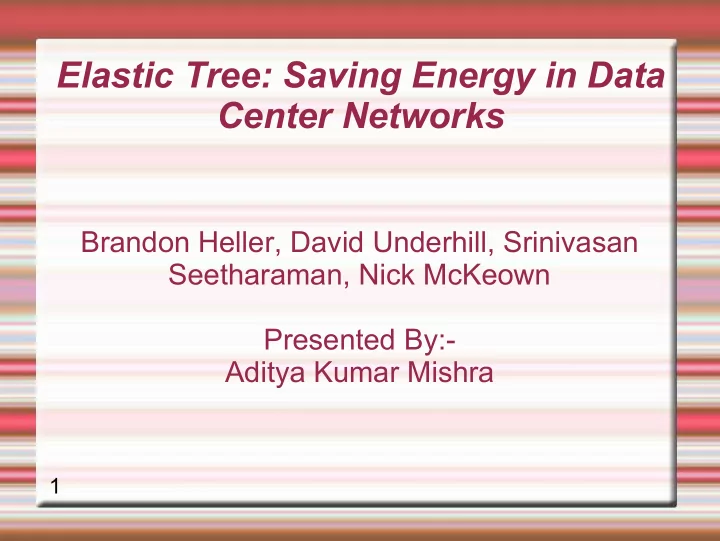

Elastic Tree: Saving Energy in Data Center Networks Brandon Heller, David Underhill, Srinivasan Seetharaman, Nick McKeown Presented By:- Aditya Kumar Mishra 1
Introduction ● Currently, most efforts focused at optimizing energy consumption at servers ● Network consumes 10-20% of Data center power 2
Introduction (Contd) Try and minimize two things ● Energy consumed by network components ● Number of active components 3
Energy Proportionality If each component is energy propor- tional, we don't need to minimize the number of act- ive components 4
Elastic Tree approach ● Input: Network topology and traffic matrix ● Decide , how to route packets to minimize energy ● After rerouting , power down all possible links and switches ● Balance performance and fault tolerance 5
Data Center Networks 6
Data Center Networks ● Are big: Scale to over 100000 servers and 3000 switches ● Are structured: Employ regular tree like to- pologies with simple routing ● Are cost-sensitive 7
Typical Data Center Network ● Often built using 2N topology ● Every server connects to two edge switches ● Every switch connects to two higher layer switch and so on 8
Typical Data Center Network 9
Traffic and Provisioning ● Typically provisioned for peak load ● At lower layers, capacity is provisioned to handle any traffic matrix ● Traffic varies ● Daily (more email in day than night) ● Weekly (More Database queries on week- days) ● Monthly (Higher photo sharing on holidays) ● Yearly (More shopping in December) 10
Fat Trees ● Are highly scalable ● Can be designed to support all communica- tion patterns ● Built from large number of richly interconnec- ted switches ● Provide 1:N redundancy ● ElasticTree benefits greatly from Fat Trees 11
Fat Tree 12
Question?? Why the name “Fat Tree”? 13
What is FAT?? The links in a fat- tree become "fatter" as one moves up the tree towards the root. 14
Power consumption of Switches 15
Workload Management in a Data Center 16
Managing a Data Center ● Performance and cost are at odds with each other ● Best performance: By spreading workload to the maximum possible ● Most energy efficient solution: Concen- trate all load on minimum possible servers 17
Quick Question If performance is not a consideration, what will be the most energy efficient solution for data centers? 18
Workflow Allocation in Data Center Done in two steps: 1. Work allocation to servers, to meet some performance criteria 2. Traffic is routed by Network. Current approach is to min imize congestion and maximize fault- tolerance 19
ElasticTree: A Network Power Op- timizer 20
ElasticTree Its a dynamic network power optimizer. Uses the following two ways to calculate traffic rout- ing ● Near optimal solution: Uses integer and lin- ear programs ● Heuristic: Fast and scalable, but suboptimal 21
Near-optimal Solution ● System is modeled as Multi-Commodity network Flow (MCF) ● Objective is to minimize total N/W power ● Usual MCF constraints like ● Link Capacity ● Flow conservation ● Demand satisfaction ● Additional constraints ● Traffic only on powered on switches and links ● No such thing as half-on Ethernet link ● Model does not scale beyond networks of 1000 hosts! 22
Heuristic Solution ● Exploits regularity of fat trees ● Assumes flows are perfectly divisible ● Using traffic matrix, compute the max traffic between an edge switch and aggregation layer ● Total traffic divided by link capacity gives the min number of aggregation switches needed 23
Heuristic Solution(Contd) agg is number of switches required in pod i N i E i is set of edge switches in pod i F(s → t) is rate of flow between 's' and 't' A i is set of nodes for which F(s → t) must tra- verse aggregation layer of pod 'i' ' r ' is the link rate 24
Heuristic Solution(Contd) N core is number of switches required in core C is the set of core switches B i is set of nodes for which flow F(s → t) must traverse aggregation layer of pod 'i' 25
Heuristic Solution(Contd) ● Heuristics assume 100% link utilization ● K-redundancy by adding k switches to each pod and N core ● Similarly max link utilization can be set to 'r' 26
Evaluation 27
Traffic Extremes ● Near traffic: Here servers communicate with other servers only through their edge switch (best-case) ● Far traffic: Servers communicate with serv- ers in other pods only (worst-case) ● For “far traffic” savings depend heavily on network utilization 28
Power Savings vs Locality Increased savings for more local communications Savings to be made in all cases! 29
Power savings with Random traffic 30
Energy savings vs N/W size and demand 31
Time-varying utilization 32
System Validation 33
Bandwidth validation ● Both, near optimal and heuristic solution very closely match original traffic ● Packets dropped only when traffic on a link is extremely close to line rate ● Ensuring spare capacity can prevent packet drops 34
Bandwidth validation, k=4 35
Bandwidth validation, k=6 36
Fault Tolerance ● MST certainly minimizes power but throws away all fault tolerance ● MST+i requires 'i' additional switches per pod and in the core ● With increase in N/W size, incremental cost of fault tolerance becomes insignificant 37
Power cost of redundancy 38
Scalability 39
Computation Time 40
Conclusion ● About 60% of network energy can be saved ● If workload can be moved quickly and easily, then the data center can be re-optimized fre- quently 41
Thank you 42
Recommend
More recommend